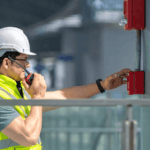
OSHA Ladder Safety – Everything you need to know
Did you know that ladder-related injuries are among the top three workplace safety violations in the US in 2021?
This comes at a time when fall protection is at the top of the workplace safety standard violations — for the 11th year in a row.
This shows how vulnerable the workers are when working at heights and the need for strong measures in place.
By following OSHA’s ladder safety guidelines, organizations can prevent many such injuries and accidents to create a safer working environment. Let’s look at some of the crucial OSHA ladder safety guidelines you need to know:
OSHA Ladder Safety Guidelines — 5 Ground Rules to Follow
1. Inspect the Ladder Before Every Use
Before using a ladder, make sure all locks are engaged securely and the steps are free of grease, oil and other slippery substances. Also, inspect ladders for defects such as missing components, cracks, frayed ropes, corrosion or other problems that could cause them to fail or break. Any damaged ladders must be removed from service until repaired.
2. Choose the Right Ladder for the Job
There are different types of ladders for various purposes. And you need to be sure to choose the right ladder for the job you are doing.

A straight ladder is the most common type of ladder. It is best suited for tasks that require you to climb up and down, such as painting a wall or cleaning windows. Each step in a straight ladder should support a load of at least 250 pounds, according to OSHA.

A portable ladder is a ladder on wheels and can be moved around easily. This is helpful for tasks that require you to be at different heights, such as stocking shelves. Portable ladders should have corrugated and dimpled surfaces with a skid-resistant coating to prevent easy slippage, along with a secure lock to hold the ladder in place when working.
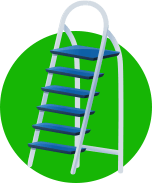
A step ladder is shorter than a straight ladder (around 6 to 30 feet) and has steps. According to OSHA, the step ladders must extend at least 42 inches above your access level or any other platform. This makes it more stable and ideal for tasks that require you to be closer to the ground, such as reaching a high shelf or changing a lightbulb.
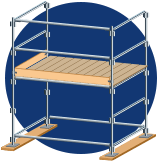
A scaffold is a platform supported by a frame and is used for tasks requiring you to be at a certain height for an extended period, such as painting a ceiling or working on a value on a top floor.
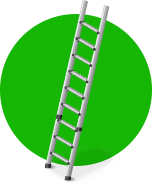
An extension ladder is taller than a straight ladder and can be extended to reach even higher heights. This is perfect for tasks out of reach of a normal straight ladder.
3. Place the Ladder on a Stable, Level Surface
Ladders can slip or collapse if not placed on a stable, level surface. Ensure the area around the ladder is free of clutter and that the ladder is not placed on anything that could cause it to move.
If it all, you need to place the ladder on slippery surfaces, secure them strongly and use barricades to keep the ladder away from the people moving around. According to OSHA, you need to anchor the ladders when placing them in the doorways, driveways or passageways.
4. Exercise Caution When Using the Ladder
Never use any ladder with a back step or pole extending out from the bottom rung unless it supports specific weight limitations or is specified by the manufacturer as safe. Don’t forget about the ever-important fall prevention measures such as using non-slip shoes and footing, placing objects under or between ladders, and using proper lifting techniques with tools and materials to prevent injury in case of a fall.
And when you’re on the ladder, make sure to stay clear of overhead power lines and communication towers when working nearby to avoid tripping hazards.
5. Stay on Top of Maintenance
Make sure that all ladders are inspected before every use and current with the latest safety codes. Inspect for worn or frayed ropes, proper fasteners, and other safety issues.
Apart from the above, here are a few more practical things you need to keep in mind when working with ladders:
- When climbing, always face the ladder and use both hands to grip the rungs.
- Do not stand on the top rung as you could lose your balance and fall.
- Wearing shoes with good traction will help you avoid slipping and falling while climbing a ladder. Avoid wearing loose clothing that could get caught on the rungs.
- Descending a ladder can be just as dangerous as climbing it. Take your time and use both hands to grip the rungs.
- Don’t leave the ladder unattended. If you need to step away from it, make sure someone else is there to watch it.
- When working around electricity with a metal ladder, make sure it has non-conductive side rails.
3 OSHA Safety Standards to Keep in Mind
3 Point Contact Rule
As per OSHA regulations, there should be 3 points of contact at all times with the ladder when climbing up or down. This is called the 3-point contact rule.
Two hands and one foot or two feet and one hand should always be engaged with the ladder to avoid losing your balance. This prevents accidents, giving you stability while climbing up and coming down the ladder.
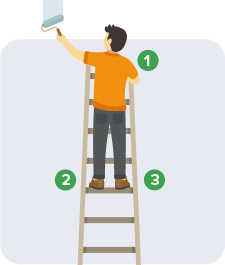
1 to 4 Ratio
The 1 to 4 ratio refers to ladders at an incline with other surfaces. This helps to establish balance with the ladder and makes it easy for the person to climb or descend.
According to OSHA, for every 4 feet of climbable height a ladder has, it must be placed 1 foot away from the wall or other surface it is leaning against to ensure its stability. For example, if your ladder is 20 feet high, you will need it to be 5 feet away from whatever surface it’s resting against.
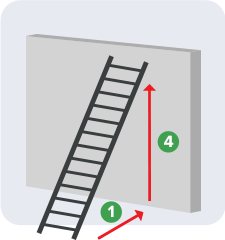
3 Feet Extension
OSHA insists that a ladder should have side rails extending at least 3 feet above the upper landing surface. The extension ensures that the person can maintain balance while dismounting the ladder.
These are some of the basic rules you need to follow when using ladders. And these should be an essential part of your audits and inspection checklists. If you haven’t yet digitized your permit to work system, Safetymint offers the easiest and most efficient digital permit management solution. Get started with a 14-day free trial.
Related read:
The meaning of PTW
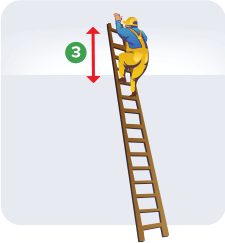

Ramesh Nair is the Founder and Principal Partner of Niyati Technologies, the company behind Safetymint.
He’s a dedicated advocate for workplace safety. Ramesh firmly believes that every individual deserves to return home safely after a day’s work. Safetymint, the innovative safety management software, emerged from this conviction. It’s a platform designed to streamline safety management, empower safety professionals, and enhance safety in workplaces.
Through his blog, Ramesh shares insights, best practices, and innovative solutions for workplace safety. Visit his social media profiles to follow him for regular updates.




